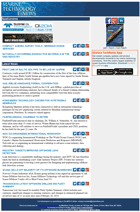Improvements in Subsea Security Technology
In recent years, commercial, scientific and military activity have increased exponentially within maritime areas. The material goods involved in such kind of activity – commercial ports, scientific research devices, expeditionary warfare platforms or others – are considered as targets by a variety of terrorists and saboteurs.
Consequently, in order to secure these assets, lot of financial and human resources were invested. Access control and the surveillance above water, until recently considered the crucial part of this securing activity, are realized through a large number of subsea security technology items such as CCTV, FLIR, RADAR, SCAS (Swipe Card Access Systems) etc.
Not such a long time ago, the manufactures and providers of security systems for maritime assets considered protection against threats from above sea as an “optional extra” for the most paranoid of their customers or for the most sensitive of the interest areas. This attitude is now considered at least self-satisfied, as more and more evidence appear about terrorist groups recruiting and training frog-men and scuba divers, as Al Qaeda does.
One of the most difficult problems to solve with a security system is the reliable detection of underwater intruders. These systems must be able to work in the most complex acoustic environments, like a commercial shipping port, where a lot of sea traffic is registered every day.
Sounds come from ships arriving or out-going, from the harbor facilities or from environmental factors – even relatively still waters create complex thermal structures affecting sound propagation. They also come from the quotidian activity of the maritime fauna.
All the above referred to the protection of fixed installations. But even greater problems are facing the vessels in ports or overseas. The attacks on the USS Cole in October 2000 and the Limburg in 2002 remind us how highly visible and vulnerable are these possible terrorists’ targets.
Sonar subsea systems
Sonar comes from the phrase Sound Navigation and Ranging and is used to detect objects and their movements in water. The best way to gather information about what happens above the water surface is through sound waves. Other types of waves, like light or radar waves, quickly attenuate as they travel in water than in air.
Sonar was the first form of subsea security technology to be applied during World War I for the detection of submarines. In time, technology improved and nowadays sonar is used for both civilian and military purposes. The development of digital computer technology makes now plotting of sonar data much easier..
The sonar systems work two modes: actively or passively. Active sonar sends an acoustic pulse and wait for the echoes. Echoes come from the water immersed objects hit by this acoustic pulse and have specific characteristics: intensity, frequency, period and time of delay from emission. Active sonar can also be used as weapon. It can be programmed to emit sounds of specific frequencies which can disturb the activity of the human brain or even cause it severe damages.
In the case of passive sonar, the submersed objects emit different sounds. The operator of radar listens and determines what or who emitted the sounds, its location and movement direction and speed..
This subsea security technology can use different types of sound frequencies, high or low, depending of the goals of the mission. If you need accuracy, you better use higher sound frequencies but you may scan only for short distances. If you need information from great distance, you’ll use lower sound frequencies, which can travel on long distances with minor loses in their intensity, but it will be very hard to determine the exact characteristics of the target – distance, shape, speed, direction.
Sonar can be disposed in different ways; they can be permanently mounted, either on fixed locations on the sea shore or submarine relief or on the hull of submarines or ships carrying them. They can be used individually or as arrays or groups, depending on the purpose.
Arrays are used to triangulate (determine) the position of the target. Such arrays of sonar have been attached on the submarine cables, offering a wide distribution almost all over the world ocean and the possibility of fast data transmission through the same cables they were located. Such military system called SOSUS (SOund SUrveillance System) was used by U. S. Navy since 1960. The arrays of this type are disposed only in the areas of military interest, so they don’t cover the entire surface of the ocean. They allow a real-time acquisition of acoustic data, but the costs are high and the access of civilians is restricted.
Another piece of subsea security technology used to determine possible intruders is the so called “Sonobuoy”. It is a relatively simple device, including a underwater hydrophone and a radio transmitter. You can use any surface piece of equipment to position it in the interest area. The recorded data will be sent through the radio transmitter to the ship or aircraft, were it will be processed. In order to determine the position of the possible intruder, one must triangulate the data from a set of sonobuoys disposed in a pattern. The device can be used just in short term detailing activities due to its short life span.
Acoustic Doppler
The “Doppler shift” refers to the modifications in the frequency of a sound produced by a moving object. The higher is the speed of the object, the higher is the frequency of the returned signal and vice versa. If the object moves towards the sound source, the return signal is higher. The device called Acoustic Doppler profiler measures the speed and direction of the targeted object and it also can trace the route the object travelled, including the departure point, due to the movement of water molecules dislocated.
Improvements in subsea security technology
During the last years the subsea security technology improved and the submarine threat was getting quieter and more difficult to detect. Nevertheless, the subsea security technology also improved. We are not speaking about new ways to detect the intruders because tracking sound remains the most reliable detection method. But we can speak about improvement in the devices used for sound tracking and recording, the sound sensors, and, especially, on the means to analyze the large amount of data collected. Enhanced computer systems offer new algorithms for passive and active detection, enhanced processing capabilities and color displays for the operators.













 December 2025
December 2025



